So you want to write a headline that goes viral?
Well, you can.
All you need is to understand why headlines go viral in the first place.
In this post, we’ll share 21 viral headlines, why they went viral, and how you can model their success…
What Makes A Headline Go Viral?
When Coschedule.com looked into the psychology of why people share content, they discovered that it’s because people want to increase the quality of their relationships with others.
People share content to increase their self esteem, popularity and standing among their peers.
Behavioural psychologist, Abraham Maslow, called this phenomenon the Hierachy of Needs:
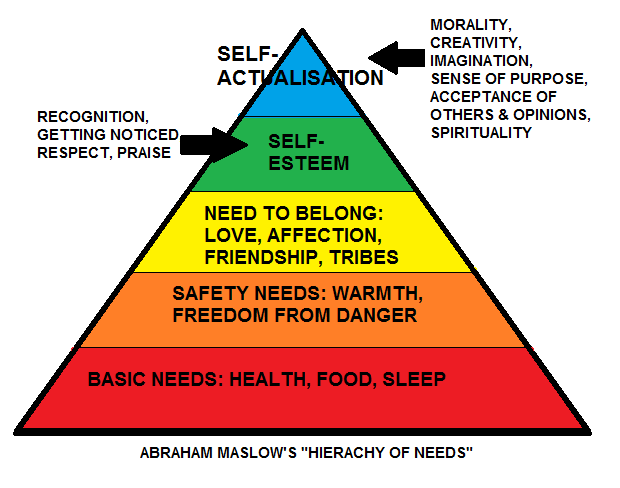
Maslow’s Heirachy of Needs shows that, as long as we have food, water, warmth and shelter, our primary need is attention, recognition and praise from others.
These factors are the driving forces behind everything we do, each and every day: including when we choose to share a headline on social media.
Why People Share Content
People share content because it is a reflection of who we are: it sayssomething about us (whether we are consciously aware of it or not).
People share content because it is a reflection of who we are: it sayssomething about us (whether we are consciously aware of it or not).
Sometimes we share helpful content, because it makes us look helpful (satisfying our need for self-actualisation).
Sometimes we share emotional, attention-grabbing content, because it helps us to get noticed (satisfying our need for self-esteem).
Sometimes we share opinionated content, because we want to show everyone what “tribe” we belong to (satisfying our need to belong).
When deciding what content to share, the headline says it all. The headline is what people notice first. It’s the headline that makes a piece of content stand out, get shared and go viral (or not).
5 Types Of Headlines Most Likely To Go Viral
There are 5 basic headline types that are the most likely to go viral:
1. List Posts
List posts provide a useful list of things. Here are some examples of list posts:
- 23 Tips To Grow A Blog (Even If You’ve Failed Several Times In The Past)
- 50 Smart Ways to Segment Your Email List Like a Pro
- 6 Little Talked About (and Possibly Controversial) Reasons Why Your Traffic Conversion Rate Sucks
- 73 Types of Blog Posts That Are Proven to Work
2. How-to Posts
How-to posts teach something: they help people achieve a desired outcome. Here are some examples of how-to posts:
- How To Quit Your Job (Even When You’re Scared Out Of Your Mind)
- How to Be Smart in a World of Dumb Bloggers
- How To Start Getting Traffic To Your Blog
3. Resource Posts
Resource posts are lengthy guides or a large amount of curated content that provides a complete solution to a specific problem. Here are some examples of resource posts:
- The Beginner’s Guide to Twitter
- Ultimate Guide to Single Optin vs. Double Optin – Which One is Better?
- The Definitive Guide To Conversion Optimization
4. Question Posts
Question posts “throw open the floor” to the readers or audience and provide direct answers to their questions. Here are some examples of question posts:
- How Long Should Your Business Take to Earn Revenue?
- If I’m so Smart Why Aren’t I Successful Yet?
- How Do I Monetize My Blog (Or Podcast)?
5. Heart-to-Heart Posts
Heart-to-heart posts say to your audience, “I am about to share my deepest, darkest/brightest, thoughts/truths, with you. Come, sit down beside me and hear my tale of how…”. Here are some examples of heart-to-heart posts:
- 33 Things I’ve Never Told You (or, How to Re-Introduce Yourself and Kick Your Watered-Down Self in the Ass)
- No, You Don’t Need to be Great at Everything – and Why You Shouldn’t Even Try
- An Open Letter to Writers Struggling to Find Their Courage
If your headline follows one of the 5 formats above, then you’re off to a great start. However, for a headline to really grab attention and go viral, it needs one final ingredient:
An infectious agent.
For a headline to go viral, it needs an element that makes it contagious.
Add the right infectious agent, and you can greatly increase your headline’s chances of going viral. (For example, Neil Patel tweaked his headline to include an infectious agent, and got a 40% boost in click through rates!)
Infectious agents create shareable content because they trigger emotions. Deep, primal emotional needs, as highlighted by Maslow’s Hierarchy of Needs.
Here are some examples of infectious agents:
- Awe
- Anger
- Anxiety
- Fear
- Joy
- Lust
- Surprise
- Shock
So, how do you put all these pieces together to create a viral headline? Let’s check out these 21 viral headlines and see…
Viral Headline #1: “40 Belief-Shaking Remarks From a Ruthless Nonconformist”
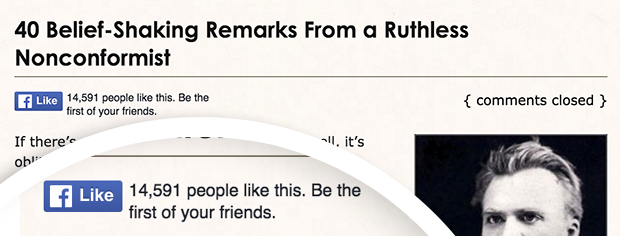
With over 14,000 shares on Facebook alone, this article from Raptitude received more social media love than most blogs see in an entire year of publishing.
What made it so shareable? Let’s analyze it and see…
Headline Type: List Post
Infectious Agents: Awe | Anger | Surprise | Shock | Fear | Anxiety
“Belief-Shaking”: Right away, this headline challenges you by stating its content will shake your beliefs. This may make you angry. Or fill you with a sense of awe. It might even make you fearful.
Having your beliefs shaken, questioned, maybe even crushed, can make you fearful because your beliefs are deeply personal. They are a big part of what makes you what, and who, you are.
“Ruthless”: This word conjures up an image of someone who doesn’t care. A renegade. A gangster. A person without mercy or regard for others.
“Nonconformist”: This word conjures up an image of someone unafraid and unconventional, doing what they want and changing the world in the process while battling against the norm. We love individuals like these, individuals who say and do things we want to do but feel unable.
Chris Guillebeau built his entire online business on being Nonconformist, such is its appeal.
Key Takeaway: Write a headline that challenges the reader, dispels myths, or presents an unconventional opinion.
Viral Headline #2: “How To Hit 1,000,000 Visitors in a Year of Blogging”

This article by Becky Mansfield was a viral hit with over a 26.2K pins on Pinterest.
Headline Type: How-To
Infectious Agents: Awe | Surprise | Shock
“1,000,000 visitors!”: Wow! A promise of huge benefit: discover how to get 1 MILLION visitors. Who doesn’t want to know how to get 1,000,000 visitors? Even if you’re skeptical, you want to click, right?
“In a year”: This promises you a desirable deadline: 1 year.
“Blogging”: This pinpoints its target audience and their biggest desire.
This headline creates curiosity: whatever your feelings about the facts inside this headline, you want to read it, right?
Key Takeaway: Promise a desired result, and a time scale for achieving it. (Hint: you’ll need to know the desires of your readers.)
Viral Headline #3: “Where To Find Free Images Online”
This guest post on Problogger about images got big viral love on Facebook, Pinterest and Twitter, all popular image sharing social platforms.
Headline Type: Resource post
Infectious Agents: Awe | Joy
This headline is powerful because it answers a burning question for many online business people: where to find free images. It’s helpful because it saves you time and effort searching.
Key Takeaway: Look for common questions or problems that people have, and write a headline that directly answers that question or solves that problem.
Viral Headline #4: “How to Quit Your Job, Move to Paradise and Get Paid to Change the World”
This post made history as the most popular on Problogger.net.
Headline Type: How-To
Infectious agents: Awe | Joy | Lust | Surprise
“Quit your job”: Who doesn’t want that? It’s a promise that makes this headline viral.
“Move to paradise”: Imagine, your life in a paradise where no 9-to-5 cubicle-cell bars you from your dreams. Another viral success promise.
“Get paid”: A huge number of people want to “get paid” for doing what they love. This is a hook that people can’t resist.
“Change the world”: An invitation to nonconformists everywhere.
Key Takeaway: Promise a big benefit, such as money, freedom, or creative fulfillment.
Viral Headline #5: “On Dying, Mothers and Fighting For Your Ideas”
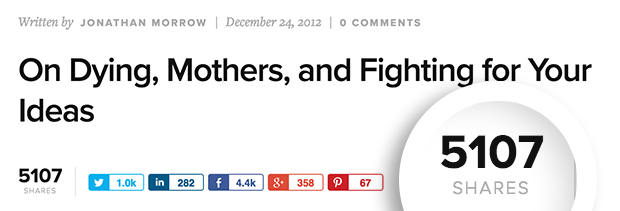
Another headline from the master of headlines: Jon Morrow, that punches heart strings to make an emotional plea: don’t let your dreams die in mediocrity – Fight to set them free.
Headline Type: Heart-to-Heart
Infectious Agents: Awe | Anger | Surprise | Shock | Fear
“Dying”: This is a strong, emotive word.
“Mothers”: Another emotive word, whatever your relationship with your mother.
“Fighting”: Yet another emotive word. It conjures up images in people’s mind of struggle, aggression.
“Fighting for your ideas”: Suggests this is a post that is going to motivate and inspire you.
Key Takeaway: Make your headline personal, motivational, and don’t be afraid to get emotional.
Viral Headline #6: “106 Excuses That Stop You From Ever Being Great”
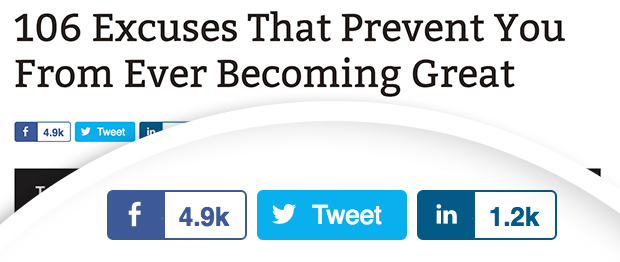
This rare guest post on ChrisBrogan.com by Tommy Walker has almost 5,000 Facebook likes and over 3,000 tweets.
Headline Type: List Post
Infectious Agents: Awe | Anger | Surprise
“106”: A big number that makes those “excuses” look all the more challenging because you might want to argue that you don’t have that many.
“Excuses”: This word is a challenge. You may not like to be told you’re making excuses but this headline challenges you with the fact that you probably are.
“Prevent you from ever becoming great”: Another challenge. This time a big one: If you don’t overcome these excuses, your dreams of being great, of becoming someone who matters, who changes lives, a non-conformist even, will never happen.
Some of the most popular, most viral headlines, challenge people to deny or accept the truth as they know it.
Key Takeaway: Laying down a challenge with your headline can make your message roar. Just make sure you have something worth reading after the headline, or people will feel cheated.
Viral Headline #7: “Why James Chartrand Wears Women’s Underpants”
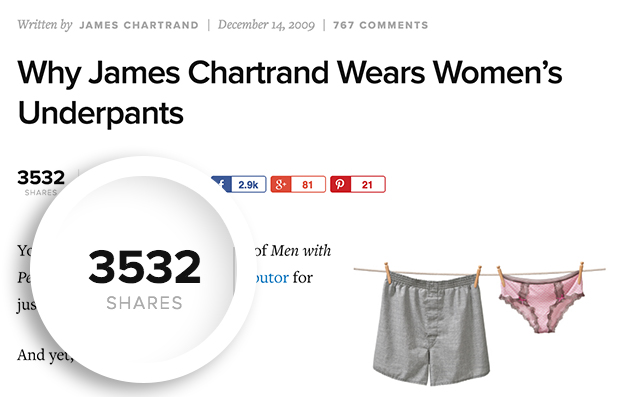
This headline shows how humor and curiosity can make a headline go viral.
A popular blogger reveals their guilty secret… or do they? (As it turns out, the real surprise isn’t the fact that this blogger wears women’s underpants, but the fact that “he” is actually a woman.)
Headline type: Heart-to-Heart
Infectious agent(s): Awe | Anger | Shock | Surprise
“Why”: Suggests it’s going to reveal something shocking.
“James Chartrand”: A (supposed) man, and a well-known man in certain circles online, who…
“Wears women’s underpants”: What!? You either laugh. Or curl your lip in disgust. Either way, you want to read about it, right?
This headline takes the gossip nature of tabloid and reality shows and gives their viral power to a blog post headline.
Key Takeaway: Gossip is contagious, so why not use it in your headline? Just make sure to fulfill your promise of revealing something interesting to read… even if it’s not precisely what the headline leads you to believe.
Viral Headline #8: “37 Tips for Writing Emails that Get Opened, Read, and Clicked”
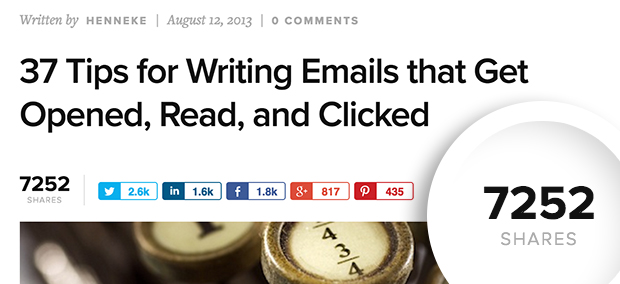
This viral headline has seen over 7,000 shares on Twitter, Facebook and LinkedIn.
Headline Type: List Post
Infectious Agents: Joy | Awe
“37 Tips”: A large number that makes this post a useful resource.
“Emails”: Grabs attention of its target audience: anyone struggling with email marketing or list building.
“Open, Read and Clicked”: Isn’t that what everyone wants who has an email list?
Key Takeaway: Get to the heart of your audience really wants and give them a practical way to achieve that result.
Viral Headline #9: “21 Settings, Techniques and Rules All New Camera Owners Should Know”
This headline’s viral success is off the scale with 419,000 shares on Facebook and over 22,000 pins on Pinterest.
Headline Type: List Post
Infectious Agents: Awe | Joy
“Settings, Techniques”: These are attention-grabbing words for anyone interested in photography and using a camera or getting better at using a camera.
“Rules”: This is a “trigger” word – it suggests that these are the only way to become better (and accepted) by other photographers. It says that this post gives information that will make you acceptable in the photography field among other, possibly more experienced, photographers.
“All”: Implies that if you don’t know what these settings, techniques and rules are, you’ll be left outside the group (and possibly feel a little dumb too).
“New”: This is a power word. This is a word that inspires strong emotion or action in readers. Copywriters have used “new” as one of the key words they use to inspire people who want to be first in line.
“New” in this headline also attracts beginner photographers and camera enthusiasts.
Key Takeaway: Get to know the power words in your niche or industry and use them. Don’t try to get fancy or clever– keeping your headline simple and to-the-point is often the best way to get attention.
Viral Headline #10: “29 Life Lessons Learned In Traveling The World”
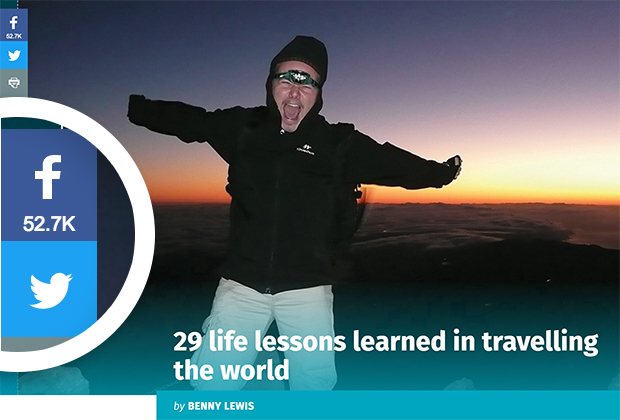
With over 50,000 shares on Facebook alone, we’re back in the realm of the super-viral headline.
Headline Type: List Post
Infectious Agents: Awe | Surprise | Joy | Lust
“29 Life Lessons”: People always want to know how to enjoy a better life, enjoy a fulfilled life, how to leave a legacy. This headlines promises them 29 lessons in how. And learned from…
“Traveling the World”: For anyone dreaming of freedom from cubical boredom, these words inspire desire and lust (envy).
Key Takeaway: People always look for advice from others who they aspire to be like. Use that to your advantage in your headline.
Viral Headline #11: “44 Social Media Tools Recommended By The Pros”
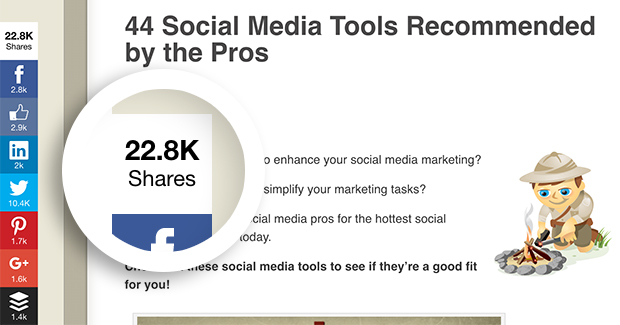
With over 22,000 shares, this post went viral across social media.
Headline Type: List Post
Infectious Agents: Awe | Surprise | Envy
“44”: That’s a long list. This increases its usefulness and quality in readers minds, even before they read the post itself.
“Social Media Tools”: This is a key phrase that gets a lot of searches because it’s a “hot topic.”
“Recommend by the Pros”: These words give this headline authority and impact because they tell people that these are not just any social media tools. They are what the pros, the authorities, the influencers, the successful social media experts use. And, if you use them too, you’ll not only get the success enjoyed by the pros, but you’ll be one of them too.
Key Takeaway: Find a hot topic in your field and add authority by getting the pros to reveal what they do to succeed.
Viral Headline #12: “5 Twitter Tools to Boost Your Productivity”
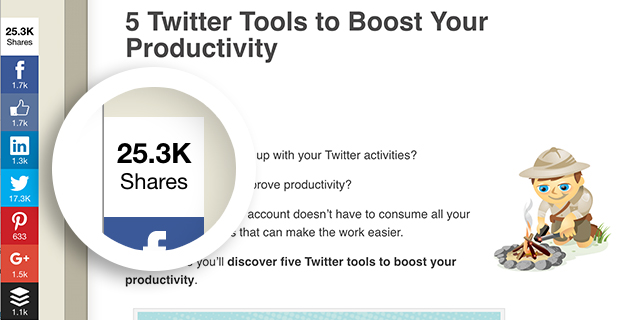
Again, this headline includes “hot topics” – Twitter Tools and Productivity. Together, these power words give this headline viral juice. Over 25,000 shares proves this.
Headline Type: List Post
Infectious Agents: Awe | Joy
“5”: Sometimes a short list can sometimes appear more important than a longer list because people think that there’s no “fluff”, and only the really important points were included.
“Twitter tools”: Anyone interested in getting most value out of Twitter are going to want to read this.
“Boost”: This is a power word – it suggests this post is going to maximize your productivity (and thereby save you time).
“Productivity”: Anyone wanting to make most of their time (and stop wasting it trying to make Twitter work for them) is going to be interested in this post.
Key Takeaway: Link “hot topics” or power words to a big benefit that solves a problem for your readers.
Viral Headline #13: “6 Ways to Use Short Video for Social Marketing”
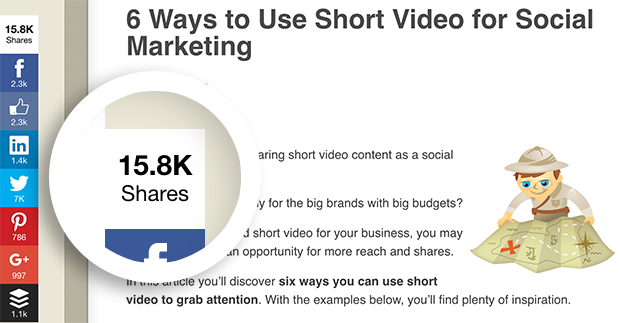
With 7,000 tweets and over 15,000 total shares, this headline shows what going viral means.
Headline Type: List Post
Infectious Agents: Awe | Joy
“6”: Subconsciously, people see these “6” as being the most important, useful, or the best.
“Use”: Reassures readers that these “ways” work and you will actually see results.
“Short video”: Video is becoming a popular tool for bloggers and marketers alike. People also like watching videos (but they don’t always have time), and short videos implies they get details they want, without taking up too much of their time to do so.
“Social marketing”: This is another “hot topic” for a viral headlines because anyone who wants to make money online wants (and needs) to know how to make social marketing and social media work for them.
Key Takeaway: Taking a topic that everyone is writing about and giving it extra juice by combining it with another “hot topic” can increase your headline’s viral power.
Viral Headline #14: “Some Practical Thoughts On Suicide”
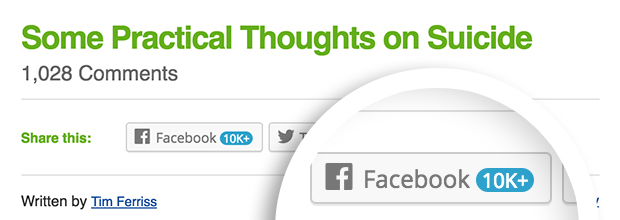
Controversial and taboo topics can make headlines go viral and this post by Tim Ferris with over 10,000 likes on Facebook proves it.
Headline Type: Heart-to-Heart
Infectious Agents: Awe | Shock | Fear
“Some”: This word used in this context is a power word because it suggests the essential thoughts. The thoughts that matter.
“Practical”: In this context, this is also a power word because it makes people feel that this is a serious post, with actionable steps. In a topic that is highly emotional, personal and little talked about but which affects many people, they are probably looking for practical advice they can feel comfortable about reading and accepting.
This headline also brings people together in a particular group: people who recognize the effects of suicide. Personal stories of triumph over adversity, or struggles with mental health, physical health or life’s dark places can help many people unite and come together in a way that they may not have been able to do in their off-line lives.
Key Takeaway: Personal stories, controversy and taboo topics work. They create curiosity for many, and for others they draw upon raw emotions.
Viral Headline #15: “The Importance of Changing Mediums: Why We Need More Polymaths in the 21st Century”
Nearly 11,000 shares on Facebook for this article on GoinsWriter.com proves how targeting who you want to read it can really add viral power.
Headline Type: Heart-to-Heart
Infectious Agent: Awe
“Importance”: This says, “You need to read this.” People want to be seen as being ahead of the game.
“Changing mediums”: Changing the way you do things – this is a challenge to people. People like to be seen as living against the norm, to be nonconformist and free of rules.
“Why”: This is a power word. It offers an answer to your questions, “Why is this happening to me?”, or “Why can’t I do what I want to do?”.
“Polymaths”: This evokes curiosity – what the heck does “Polymaths” mean? Or maybe you do know what it means, and sharing this post shows that you are a part of the elite group who does know what it means. It also just sounds “cool”. (Cool is another infectious agent from Maslow’s “Hierarchy of Needs”.)
As Derek Sivers put it: “proudly exclude people”, because this can get your headline seen by more people who will really like it and get most impact out of it.
Key takeaway: Exclusivity can be contagious, especially in headlines, because it plays on our need for respect.
Viral Headline #16: “The Diderot Effect: Why We Want Things We Don’t Need”
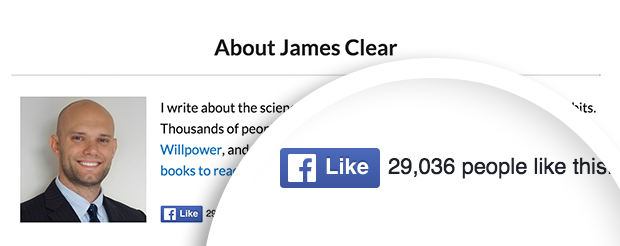
This headline by James Clear with over 29,000 shares on Facebook again uses what I like to call the “Derek Sivers Exclusion Technique”.
Headline Type: Heart-to-Heart
Infectious Agents: Awe | Surprise | Shock
“The Diderot Effect”: This introduces curiosity – what is The Diderot Effect? How does it effect me? Should I care? People want to know.
And because of its unique subject, people want to share it, either to be seen to be in the know or because it piqued their curiosity.
“Why”: Here’s that power word challenging people again.
“Don’t need”: This is a direct challenge to everyone who sees it because it suggests that you’re either greedy, disillusioned, or spoilt.
“And what to do about it”: Solutions always favor attention by saying, “Hey! There’s hope for you yet. And here it is.”
This headline also speaks to those interested in minimalism and simplicity.
Key Takeaway: Naming your solution in your headline can increase its viral power. If your solution doesn’t have a fancy name, then give it one: a name increases the perceived value of your solution and incites curiosity.
Viral Headline #17: “Are You Good Enough?”

How did this simple question get nearly 3,000 shares on Facebook ?
Headline Type: Question
Infectious Agent: Anger | Anxiety | Fear | Surprise | Shock
Are you good enough?: It challenges people. It asks a question almost everyone asks of themselves, wondering if they are good enough to be loved, accepted, recognized, praised… all of Maslow’s needs.
You want to know the answer, right? So, you click. And you share.
Key Takeaway: Ask a big question that drums up deep, human desires.
Viral Headline #18: “9 Things Managers Do That Makes Good Employees Quit”
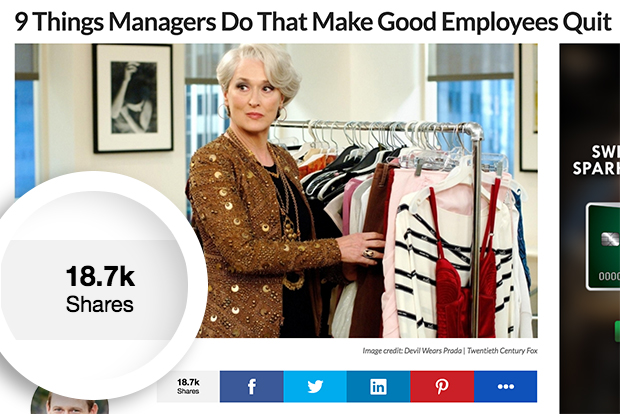
This headline had over 18,000 social shares.
Headline Type: List Post
Infectious Agents: Awe | Anxiety | Fear | Shock | Surprise
“Things”: This is a power word, or a “teaser word” in this context.
“Make Good Employees Quit”: If you can relate as a disgruntled employee, this teases you with the possibility that you’re not wrong, your boss is the problem.
This headline sets up a division between managers and employees that is bound to get a response. Either, you knew it all along so you share this headline as proof. Or you know it’s not true and you share it as another way “bad” employees blame managers instead of themselves.
Key takeaway: Confirming people’s beliefs can be as powerful a tactic as challenging them, because people have a strong desire to be proven right.
Viral Headline #19: “Why I Stopped Selling SEO Services and You Should, Too”
This guest post by Ryan Stewart on Moz.com is a headline offering a bold challenge:
SEO doesn’t work (at least not the way you think it does).
This challenge resulted in some serious shares on Twitter, LinkedIn and Facebook.
Headline Type: Heart-to-Heart
Infectious Agents: Awe | Anger | Surprise | Shock
“Why”: This word in this context sets up the feeling in people that they are about to have their beliefs shaken.
“Stopped selling SEO Services”: That’s a controversial statement.
“And You Should, Too”: This implies that there is something wrong with anyone selling SEO services, so if that applies to you, you can’t help but want to know the reason why.
This headline is controversial. It goes against the norm and challenges your beliefs.
Key Takeaway: Go against the grain and challenge industry doctrines and your headline will be irresistible.
Viral Headline #20: “Why SEO Is Actually All About Content Marketing”
This headline got a ton of shares on Twitter with over 20,000 tweets. Can you spot the two big reasons why?
Headline Type: Heart-to-Heart
Infectious Agents: Awe | Anger | Surprise | Shock
“Why”: There’s that power word again!
“SEO”: This is a popular keyword. Did you guess this as one of the two big reasons for this headline’s viral success?
“Content Marketing”: Did you guess this keyword phrase as the second big reason? Kudos to you if you did.
“Actually”: This says that all those other posts about SEO have been misleading you and now, you’re going to discover the real truth.
Key takeaway: Getting the right words into your headline and targeting it at the right audience can help you turn a weak headline into an irresistible one.
Viral Headline #21: “How To Write A Blog Post: The Definitive 10,273-word Guide”
This awesome post by Kevin Duncan on BeABetterBlogger.com with its headline was a viral hit on Google plus.
Headline Type: How-To | Resource
Infectious Agents: Awe | Joy | Surprise | Shock
“Definitive”: This is a power word. It stamps its authority on the matter. It says this guide is the only guide you’ll ever need.
“10,273-word”: 10,273-words? Wow! Must mean there’s a lot of detail and information in it. The large number is what gives this headline authority.
Key Takeaway: Long posts can be big hits with readers (as Neil Patel found out when his 4,000+ word blog posts helped him grow his blog to over 100,000 visitors per month).
So what can we learn from 21 viral headlines? Out of the 21 headlines…
- 9 are List Posts
- 7 are Heart-to-Hearts
- 3 are How-tos
- 2 are Resources
- 1 is a Question
List Posts and Heart-to-Hearts are really popular because they work really well. Just remember to include infectious agents, words that grab attention, stir up emotions, and appeal to people’s deep needs and desires.
How to Start Writing Your Own Viral Headlines
Follow these steps to write your own viral headlines…
Step 1. Really get to know your audience.
This means taking time to decide who you want coming to your site.
What makes them tick? What are they looking for? What do they share and who do they follow?
Know your audience through and through, and crafting a winning headline becomes so much easier.
Step 2. Know where your audience hangs out.
What is your audience’s favorite social media platform? You’ll notice that some of these viral headlines got more shares on one social media platform versus another. In some cases, that’s because some headlines are better suited to one platform over another.
So before you write your headline, figure out where your audience hangs out and what your best sources of traffic are. Armed with that information, some unique, new headline ideas may come to you.
Step 3. Discover your audience’s infectious agents.
To find your audience’s infectious agents, follow them on social media and take note of what they’re sharing. Look for patterns in the words or phrases that keep recurring in topics, links, headlines, they share most.
That way, you’ll know exactly which emotions to hit with your headline.
Step 4. Layer in those infectious agents.
It’s OK to start with something bland. Just keep working on your headline by layering in your infectious agents, and then eventually you’ll have a winner.
Here’s an example of the process:
Bland headline: How To Get More Traffic To Your Blog
With added emotion: Why Nobody Visits Your Blog
With added curiosity: 3 Little-Known Reasons Nobody Visits Your Blog
With added promise: 3 Little-Known Reasons Nobody Visits Your Blog (and What To Do About It)
With added emotion: Why Nobody Visits Your Blog
With added curiosity: 3 Little-Known Reasons Nobody Visits Your Blog
With added promise: 3 Little-Known Reasons Nobody Visits Your Blog (and What To Do About It)
See how much better the headline got after adding in more infectious agents? That wasn’t so hard, was it?
Conclusion
Writing viral headlines isn’t rocket science: it just takes an understanding of what causes people to share.
The critical point to remember is that people share content because of what it shows about them. Start with a good base (one of the 5 types of viral headlines) and then layer in your infectious agents (remembering to make use of Maslow’s needs) to make them truly irresistible.
Recommended Resource: Need to jumpstart your content marketing results? Get more traffic and conversions with our Ultimate Guide to Content Marketing in 2018.
By modeling these 21 examples, you can craft your own viral-worthy headlines, and you’ll be well on your way to enjoying their success.
Which was your favorite viral headline? Why? Let us know in the comments below!

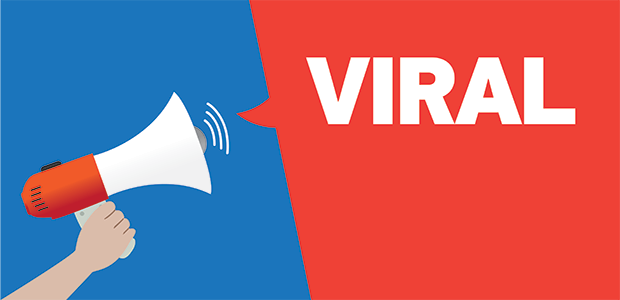



No comments:
Post a Comment